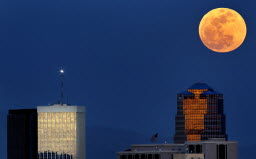Next Wednesday, March 23, there will be a partial eclipse of the full moon as it passes through the Earth’s penumbra (partial shadow).
This will cause the moon to darken somewhat, but less so than in a total eclipse where the moon enters the Earth’s full shadow (umbra). In Tucson, the moon enters the Earth’s penumbra at 2:40 a.m. Wednesday, with the maximum eclipse at 4:47 a.m. The moon sets at 6:33 a.m. prior to eclipse end at 6:53 a.m. and after sunrise at 6:23 a.m.
This weekend we also bid farewell to those long winter nights, and officially welcome spring.
The Earth moves around the sun completely once a year, which from our point of view causes the sun to slowly drift across the sky from day to day.
When the sun crosses directly over the equator from the southern to the northern part of the sky, winter officially gives way to spring.
The time when this happens is around March 21 and is variously called the vernal (spring) equinox or March equinox. “Equinox” means “equal night”— the hours of day and night are supposedly equal.
For Tucson’s latitude of about 32 degrees north, the times of equal daylight (from sunrise to sunset) and night (from sunset to sunrise) are five to six days before March 21, and five to six days after Sep. 21.
This year, the vernal equinox is officially on Saturday night at 9:30 pm.





